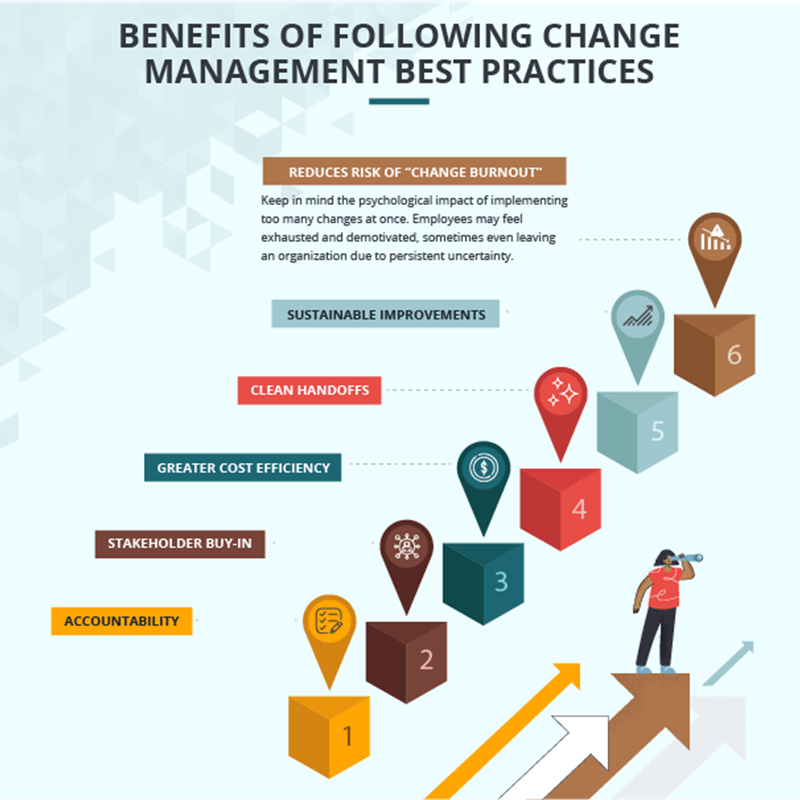Erin joined the SMIT Team in 2017. Her passion for technology and commitment to helping others inspired her career transition from Transportation Safety & Compliance to IT.
Change Management Basics for Technology Refreshes

Once you've completed a technology audit and prioritized the order in which you'll close gaps in your infrastructure, it's critical to remember that there are actions you must take prior to implementation for change to be successful and well-received by your team.
Change in any environment, especially technology environments, produces stress among those who implement or are affected by the change. This is why change management is so critical for successful implementation.
Change management is an approach that deals with the change or transformation of organizational processes, objectives and technologies. The goal of change management is to find strategies to implement and govern transformation while also assisting people in getting accustomed to it.
Applying change management best practices can enable your organization, regardless of size or industry, to scale and adapt to changing market conditions without losing key team players.
Five Elements of Effective Change Management
1. Identify
Most change management strategies recognize that identifying what to improve creates a solid foundation for clarity, ease of execution and success.
Since most changes are made to improve a process, a technology or a result, identifying the objective and clarifying goals is crucial. This also involves selecting the resources and individuals capable of facilitating and leading the initiative.
Start by asking the following questions to gain a better understanding of your core mission:
- What are you changing?
- Why is this change occurring?
- Which systems and processes might be affected?
- How would this affect employees, customers and others?
2. Evaluate
Change evaluation attempts to analyze crucial transformations before letting those changes integrate into usual operations.
Here are a few suggestions for the evaluation stage:
- Examine technology mapping and dependencies to ensure you understand the implications of pulling specific systems offline for updates.
- If the failover* operation isn't an option, assess peak usage for all affected users to ensure that system downtime isn't scheduled during peak usage times.
- Determine the processes that need to be modified as well as the individuals who oversee them.
- Define how various internal and external user groups will be affected.
* The capability to switch to a reliable backup system instantly and seamlessly is known as failover.
3. Manage
These are the areas that require your attention:
- Seek an executive sponsor to propel your project forward and hold you accountable for deviation from your objectives.
- Before detailing your change management strategy, meet with appropriate team leaders to discuss your plan and solicit their views.
- List and connect with relevant process owners and provide them with implementation deadlines.
- Know which platforms and technologies will be affected by upcoming changes. Remember to gather emergency contacts to tackle unforeseen mishaps.
4. Create
After completing the previous steps, create a change management strategy and draft an expected implementation timeframe.
The change management strategy you create must be comprehensive to act as a roadmap defining the concrete steps your organization will have to take to implement the change management process. This is crucial to avoid disrupting workflows and assist your team in navigating this change.
5. Implement
Once all key stakeholders have approved the change management strategy, it’s time to put the changes into effect. This frequently requires cross-team collaboration and, on occasion, the support of third parties such as technology suppliers, consultants or a managed service provider (MSP).
Collaborate for success
There’s no way around it — dealing with change is hard. Without a defined strategy in place, avoidable inconsistencies are more likely to occur and you risk disrupting essential operations and losing valuable team members due to exhaustion. Working with a specialist MSP like Superior Managed IT can help you reduce organizational stress while updating your technology ecosystem.
An expert like us can take a significant burden off your shoulders, allowing you to focus on other critical business matters. Contact us to develop a change management strategy for your upcoming technology infrastructure refresh.
1306 County Rd F West
Suite 200
Minneapolis, MN 55112
Service Desk: 612-788-9233
Sales: 612-999-6200
We're here to help
Ready to secure and streamline your IT?
Contact us today to see how we can help secure the future of your business.
